Modern outdoor clothing is a miracle of science. Polyester, nylon, and other synthetic fabrics and blends have a combination of strength, weight, comfort, and protection that our fur-wearing ancestors could never have dreamed possible. But this stuff stops being amazing when you get too close to a fire and burn a hole in it, or fall down a ravine and rip it up.
Synthetic fabrics have two big drawbacks: they’re vulnerable to open flame, and once damaged they’re difficult to repair. These issues aren’t as big a deal when you’re on a hike or camping trip, because you usually can make do until you get back to civilization. But what if civilization isn’t around for you to go back to? What if you can’t just toss that outer shell you pin-holed while cooking, and head over to REI to pick up a replacement?
Read more: Wool/nylon blends are superior mix of old and new, and make for great prepper clothing.
If you want clothing that will survive the apocalypse, or even just get you through a long-term primitive living situation where you can’t count on the stores being open for a while, then you’ll have to go old-school. In my own prepping, I’ve skipped the furs and the Mad Max leather, and made a big bet on waxed canvas and waxed denim.
Summary:
- The problem of flying embers from a campfire or grill burning pinholes (or worse) in synthetic gear isn’t a huge problem for short- or medium-term prepping, but the longer you plan on using an item made from modern plastics, the bigger of a deal this could turn out to be.
- Cotton canvas can shrug off embers fairly well, especially when it’s waxed. And if the weave is tight it doesn’t light easily when briefly exposed to flame.
- Waxed cotton has a number of other benefits for long-term use, namely extremely high abrasion and puncture resistance, a usable lifespan measured in decades, and some amount of water resistance.
- Waxed cotton’s water resistance can be easily renewed indefinitely by applying common waxes like beeswax and/or parafin. (Compare to the advanced coatings on synthetics, which still have to be renewed but aren’t always readily available.)
- Regular (unwaxed) cotton canvas is also very tough and long-lasting, and is easily “waterproofed” in the field by throwing a cheap poncho over it. The cotton duck used in most popular workwear can be easily waxed with aftermarket waxes and a heat gun.
- Waxed cotton has some major downsides: weight, extremely long drying time if it does soak through, lack of breathability, and (for very heavy canvas and wax combos) stiffness.
- My own first-hand experiences, and those of others I’ve encountered on forums, indicate that comfort factors like breathability and warmth vary widely with the brand and weight of the waxed canvas material.
Not all cotton is rotten
Waxed canvas has made a major comeback in the last few years, not so much with the outdoors crowd but with urban hipsters and bikers. This classic “heritage” material ages beautifully and lasts for decades, and it shrugs off punctures and abrasion while offering some protection against rain and snow.
I personally got into this material out of a desire to have more flame-resistant outerwear. This might strike you as an odd concern, but it’s a much bigger deal than you may think. I wrote a deep dive on the problem of fire and synthetic clothing, but the bottom line is that people in primitive living situations spend a ton of time around fires, which makes melt-prone clothing a problem.
In addition to the fire factor, there’s a common durability and sustainability problem with the coatings that are applied to most outdoor gear to boost their resistance to the elements. Water and fire-resistant fabric coatings wear off and have to be re-applied every few years. Synthetic DWR coatings from companies like Schoeller can also crack, peel, and otherwise degrade with time and use.
Waxed canvas has to be re-waxed once a year or so, but this can be done with easily obtained paraffin and/or beeswax. So the material has a sustainable and renewable quality that more advanced textiles can’t match.
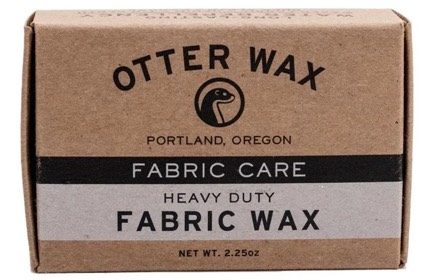
Otter Wax
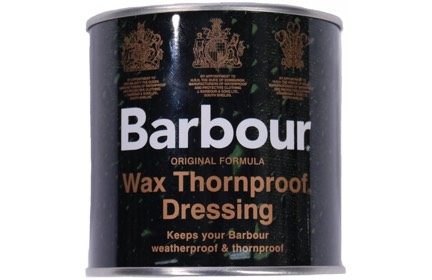
Barbour Wax Dressing
I’ve also been thinking about adding unwaxed canvas — e.g. cotton duck cloth workwear from Carhartt, or some of the canvas clothing from boutique brands like Triple Aught Design — to my preps, because it lasts so long and holds up under crazy levels of abuse. Sure, cotton duck isn’t waterproof, but when I used to work outside we had a simple solution for keeping our Carhartts dry in a downpour: throw on a cheap poncho. Problem solved!
Then there’s the repairability factor to consider. Natural materials can take to stitching and darning better than synthetics, so that rips and tears are less of a big deal.
Finally, unwaxed canvas workwear is an amazing value in terms of price and long-term durability. Brands like Carhartt, Walls, and Tough Duck will give you decades of daily use without falling apart.
How does waxed cotton work?
Cotton fibers are hollow, and can absorb multiple times their weight in water. In fact, cotton fibers use capillary action to suck up water like a straw. This ultra-absorbent quality of cotton is why so many bath towels are made of it, and it’s also why it called “death cloth” in outdoor circles.
If you’re wearing cotton clothing in the outdoors and you get caught in a downpour, the material will absorb water and hold that water close to your skin. Even if it’s not actually that cold out, having soaked cotton close to your skin for a long enough time can induce deadly hypothermia.
Waxed cotton actually takes advantage of cotton’s absorbent properties to make it waterproof. The trick is that you fill the hollow cotton fibers with wax, so there’s no space left for water to soak in.
At least you’re not wearing fish oil pants
The predecessor to waxed canvas is oil cloth — i.e. cloth where oil is used to fill the fibers, instead of wax. This material is also called “sail cloth”, because it was once used for the sails of ships. Canvas sails were soaked in oil that made them waterproof, and sometimes those sails were repurposed to make waterproof outerwear.
The original oil used to make oil cloth was probably fish oil, discovered by accident no doubt when some fish oil soaked into a patch of canvas. But linseed oil was soon adopted for this purpose, so that boat sails and canvas rain gear were soaked in it to make them waterproof.
Linseed oil eventually turns yellow as it ages, and this is the origin of the iconic yellow raincoat and rain pants that sailor and fishermen wear.
There are some companies that still make “oil finish” gear — Filson’s oil finish line is probably the biggest and best known. But this is now almost always a wax of some kind with oils added to make it softer and easier to apply. The more oil in the the finish, the easier it is to both apply to and rub off of your clothes. The finish from new or freshly refinished Filson garments can get everywhere, and in my experience the oilier garments feel really clammy when you put them on in the mornings — even during a hot summer.
The better waxes aren’t oily, which means they have to be heated in order to really get them to go into the cotton. But the upside is they don’t rub off.
Best wax for rewaxing canvas
For either restoring the finish on a waxed cotton garment, or waxing a new garment, I use a heat gun and one of the following waxes:
- C4X wax: the high-tech option from Halley Stevensons
- Otter wax: the hipster go-to
- Barbour wax: the standby from the storied British maker of waxed canvas coats
- Filson wax: the America answer to Barbour wax
My research and personal experience suggest that the C4X wax from Hadley Stevenson is the best option for waxing. It’s a little more difficult to apply than the other waxes, but it does not melt at warmer weather temperatures, and gives a very clean, easy-to-maintain finish.
The main drawback to the C4X wax is that it’s expensive, and I’ve only ever found it in small bars. I’d love to buy a tub of the stuff if I could get my hands on such a thing.
Waxed canvas downsides
Waxed canvas has a few major downsides that are worth keeping in mind as you think about the role this material might play in your preps:
Weight: Waxed cotton is quite heavy, to the point that a good-sized waxed canvas jacket weights a few pounds, vs. a few ounces for a comparable jacket made of modern synthetics. The weight factor is a huge problem if you’re going to be on-foot for any length of time.
Comfort: The comfort level of waxed canvas varies a great deal from brand to brand and material to material. Lighter 4 oz. and even 8 oz. canvases can be breathable and flexible, whereas heavy 15 oz. waxed canvas can be like wearing thick, stiff vinyl. Whether a particular garment is comfortable or miserable depends on the fabric, the wax (both the amount and the type), the weather, and the wearer.
The comfort level can change throughout the day, too. My Filson tin cloth pants (I believe they are 15 oz. canvas) are cold and stiff in the mornings, and within a few hours of putting them on they’re hot as blazes.
I have a number of waxed canvas jackets, in contrast, that are fairly pleasant to wear, although I’ve not really pushed any of them under the same camping conditions as my Filson gear.
Water resistance: The whole point of waxed canvas, apart from durability, is water resistance. But it’s not entirely waterproof, and if the cotton fibers do soak through then they take forever to dry out.
Price: Companies are charging crazy markups for waxed cotton gear and outerwear nowadays. Synthetics are far cheaper and a better value.
My waxed cotton wardrobe
I own a number of waxed cotton garments that have seen varying degrees of use. Here are the main ones in my collection, along with some thoughts on each:
Triple Aught Design Talisman Jacket

I went through a big phase of wanting an updated version of my old army surplus M65 field jacket, so when I found the Talisman from Triple Aught Design ($375) I knew I had to have one. At some point this year, it went on sale — a rarity for this company — so I scooped it up at a steep discount.
Pros: The jacket is stunning to look at, and it’s extremely well made and comfortable. It fits a little big, but this is apparently by design — they want to leave you plenty of range of motion. This generous fit also makes it very easy to layer with.
This jacket is long enough to cover a pistol carried outside-waistband, which makes a great option for concealed carry in the winter. It also has plenty of generously-sized outer and inner pockets to hide other gear, like mace, a phone, a sap, a wallet, or anything else.
The Talisman has just enough bulk that you really feel like you can live in it for an extended period. If you’ve ever worn an original, Vietnam-era M65 field jacket with a liner installed, then you probably know what I’m talking about. There’s almost a feeling like you’re wearing a shelter, but it’s quite comfortable.
There’s a nice hood tucked into the collar that I can use in a pinch, but mostly I leave it tucked in.
I like that this coat has both a zipper option and buttons. I’m extremely wary of zippers in any item of clothing that’s supposed to be a prep. I’ve just had too many zippers go sideways on me, and it takes a visit to a tailor or cobbler to sort out. So the buttons give a nice backup option in case the zipper has problems.
The wax finish on this jacket is from Halley Stevensons in Scotland, and it’s one of their modern waxes that feels very soft and doesn’t rub off. There’s a world of difference between this and, say, Filson’s tin cloth finish — they’re not even in the same ballpark. This Halley Stevensons wax is to the traditional finishes like linseed oil as modern stainless steel is to iron.
If I have to bug out with just one coat, it’s going to be this one. It has the combination of bulk, length, durability, and features that I look for in a bug-out coat. It’s not my daily driver (that would be the Rogue Territory Waxed Supply Jacket), but is my “one coat” coat.
Cons: So far I’m loving this coat, but it does have two downsides. First, it’s a lint magnet. This is a problem with all dark waxed cotton products. The material really picks a lot of lint, and that will stand out on the darker pieces.
The other problem is the lack of handwarmer pockets. This absence of hand warmers is in keeping with the M65 design that the Talisman tries to update, but personally, I like being able to easily slip my hands into some side pockets and warm them up. I wish Triple Aught Design had been willing to deviate from the M65 a bit more to accommodate this type of pocket.
Rogue Territory Waxed Supply Jacket (Lined)

Pros: The design is sort of “chore coat” meets trucker’s jacket, so it rides high enough that if you’re carrying something in a holster or a sheath you can still easily access it. But it’s low enough that if I’m concealed carrying a pistol inside-waistband, it covers it.
The Japanese-made wool lining is comfortable even in a t-shirt, and there’s a taffeta nylon lining inside the sleeves that’s amazing. For colder weather, it’s easily worn as an outer layer in conditions down to below freezing. I often layer it on top of the wool Praetorian Hoodie from Triple Aught Design.
The build quality of this garment is off-the-charts. Handmade in Los Angeles, there’s really no comparison between this and most of my other coats. You can really feel the care that went into this thing. A lot of the seams are double-stitched, and even the shank buttons are screwed tight and feel like they could survive the apocalypse.
The wax finish on the 10 oz. canvas is a more modern, softer finish of the same feel and quality as is on the Talisman. If it’s not a Halley Stevenson wax job, it’s very close because it feels identical.
As crazy expensive as this jacket is, I’d buy it again all day everyday. And in fact, if they come out with a black version of the exact one I have (i.e. both waxed and wool lined), I probably will.
If for whatever reason I had to bug out wearing this, I’d feel fine about that. It’s my second choice after the Talisman as a “one coat” coat. The only reason it’s not my first choice is the lack of bulk and the more limited pocket options.
Cons: This coat is expensive, but you get what you pay for. The only real complaint I have with it is that the openings on the hand warmer pockets are a bit small. I have large hands, and I have to squeeze them through. The pockets themselves are plenty large, so it’s just the openings are weirdly on the small side.
Gustin M65 field jacket
I picked up this Gustin M65 Waxed Field Jacket ($160) when I was in my M65 replacement phase, and it was just $130. I figured it was inexpensive enough to try taking a chance on, and that I could flip it if I hated it. Luckily for me, I really like it, but it’s not perfect.
Pros: This jacket looks nice and fits well. The cut is modern and a bit tailored, and in general, this is something you’d see someone in and think “nice jacket!” It has the standard-issue M65 pattern pockets, but with a banded collar instead of the traditional hooded collar.
Like the Talisman, this has both a zipper and usable buttons as fastening options.
The other big advantage of this is how inexpensive it was. If I end up needing a waxed jacket for work around the property, this is going to get called on. I didn’t spend so much on it that I worry about messing it up.
Cons: The big con here is apparent quality. It just doesn’t have that hand-crafted, overbuilt quality to it that, say, the Rogue Territory jackets have. It feels like a relatively inexpensive waxed jacket, which it is. (It’s not cheap by most work jacket standards, but it is by waxed jacket standards.)
That said, back when I used to shop at places like Nordstrom I’d buy designer coats of about the same quality as this one for a multiple of the price just because of the name. So I have jackets from, say, John Varvatos that aren’t even as good as this but cost a lot more.
This jacket lacks a lining of any kind, which is fine for the price and for how I intend to wear it. But it does mean that the wax can come off a little on your clothing, at least in the beginning. This isn’t a huge problem so far, though.
As with the Talisman, there are no handwarmer pockets.
Flint & Tinder Waxed Trucker Jacket
I got the Flint and Tinder Waxed Trucker Jacket ($240) at a time when I really wanted a black waxed canvas option — I’d have skipped it if I had known that I would eventually score the black Talisman at such a steep discount. But there was a sale going at Huckberry, and it scratched an itch, so I bit.
Pros: The best thing about this jacket is the classic styling. It’s easy to wear with almost any outfit, and it has that same just-right-for-EDC length that the Rogue Territory jacket has. I end up reaching for this quite a bit, lately, as it’s just so easy to match with whatever I happen to have on at the moment.
In general, I think the trucker jacket as a category of coat is a great, three-season EDC type of jacket. There’s a reason these have been so timeless and popular.
Cons: As with the Gustin M65, the main con to this jacket is that it’s basically a fashion type of coat and not a real hard-use piece of field wear. It has that mass-produced, higher-end department store feel to it, and lacks the substance that the Rogue Territory does.
As for materials, the 7 oz. canvas is a little thinner than some of the other coats, making it lighter and more breathable but less durable. The inner lining is cotton flannel instead of wool, so that’s another knock against it in my book. I’m a big fan of wool for a whole bunch of reasons, but the big one, in this case, is that if I’m wearing the jacket with a t-shirt and I sweat in it a bit, the Rogue Territory’s wool lining will handle that a lot better than this jacket’s flannel.
I couldn’t see buying this again, given that Rogue Territory’s jackets are not much more expensive and a noticeable notch up in build quality and materials.
Filson Oil Finish Single Tin Pants
These twenty-year-old, pre-private-equity-buyout, made-in-Seattle Filson Oil Finish Single Tin Pants ($195) were my very first piece of waxed cotton gear. They are bombproof. I can walk through the worst briars and it shrugs them off. And yeah, they laugh at flying embers and sparks from a campfire.
I’ve never tried to wash or clean these things in any way. I’ve worn them from Alaska and the Yukon to the Texas desert, and when I’m done with them I just toss them in the bottom of the closet until the next time. They’re still going strong, and the leather trim on the bottoms is a nice touch that I wish more pants had.
My main dislikes are around smell and comfort. They smell kind of like a giant crayon — it’s hard to describe. It’s not unpleasant, but also not pleasant. And they alternate between stiff and cold and flexible and hot.
These pants are also pretty shapeless, saggy, and seriously lack for pocket options. In all, they’re a good basic pant, but I think there are better options for the $195 they’re asking for them nowadays.
SAINT Dyneema Cargo Pants
My SAINT Dyneema Cargo Pants ($150) are an outlier in this review because the only reason they’re waxed is that I waxed them myself. I bought a few bricks of the Halley Stevenson C4X wax and went to work with a heat gun on them.
This was a long, irritating process, and the results are uneven and odd-looking. I do not recommend trying this. That said, I am actually pretty happy with the resulting bug-out pants. They have all the benefits of these great cargo plants, plus added durability and weatherproofing.
I keep these in a drawer with some other bug-out clothes, and I wear my second pair of these that I left unwaxed.
Pros: The unwaxed version of these SAINT cargo pants are my favorite pants right now. I wear them all the time for their great blend of comfort, utility, and toughness.
The denim these pants are made of is interwoven with Dyneema fiber, making them ultra tough. They’re basically motorcycle armor that I’m wearing as casual wear. I also go camping in these.
Cons: These pants aren’t perfect, and the first downside is that they’re heavy. You’re really adding some weight to your loadout when you put these on, and the waxed versions are even a few ounces heavier with all that wax fused into the fibers.
The other downside to these pants is that they fade easily. They just haven’t held their color very well, even though I’ve only washed them maybe twice. I chalk this up to the Dyneema, which I suspect loses its color really quickly the same way Kevlar does. (Kevlar shoelaces are notorious for going from black to gray in a few weeks of wear.)
The main problem with these pants is that you can’t get them currently. They’ve been out of stock for months, and I have no idea when they’re coming back. I’m assuming this is a pandemic-related supply issue, since the pants were regularly restocked before that.
GN waxed canvas pants from Red Clouds Collective
After having them on my list for a long time, I finally picked up the ($300) GN waxed canvas pitted work pants. I initially bought the wrong size, but the RCC team was good about taking the return and setting aside a pair for me in the correct size with the same color.
Having worn these quite a bit now, they’re my new favorite pants. These have the “just one pair of pants to bug out in” spot in my doomsday wardrobe. I love the fit, the materials and build, and the thoughtful features. The pockets are perfectly sized and placed, and everything was clearly carefully thought out.
Pros: High-quality waxed canvas, triple-stitched seams, rivets at key stress points, and double-reinforced fronts. Basically bombproof. Also, the knife pocket on the left and multitool pocket on the right are perfectly sized for my fixed blade and multitool combo.
Cons: It’s waxed canvas, so it has the same problem all waxed canvas pants have: they’re hot when it’s hot out, and cold when it’s cold out. They’re also pretty heavy.


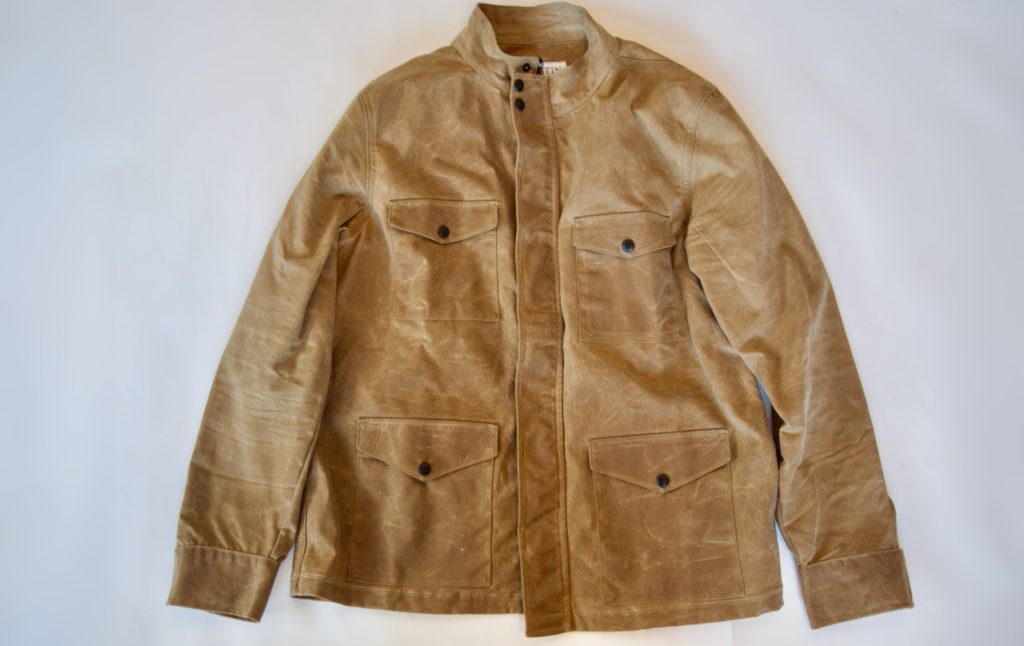


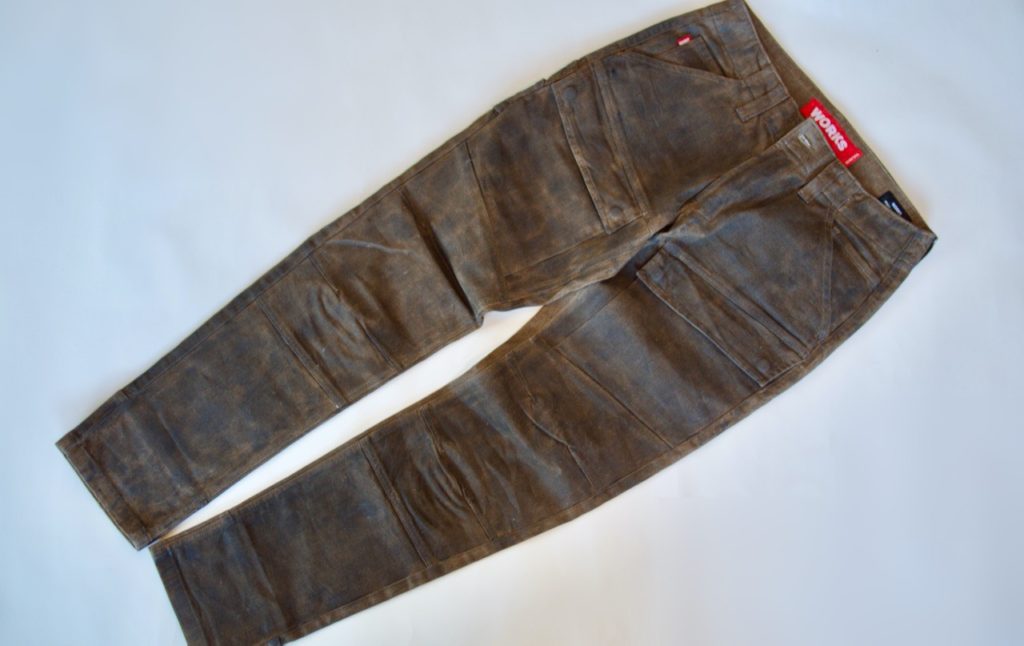


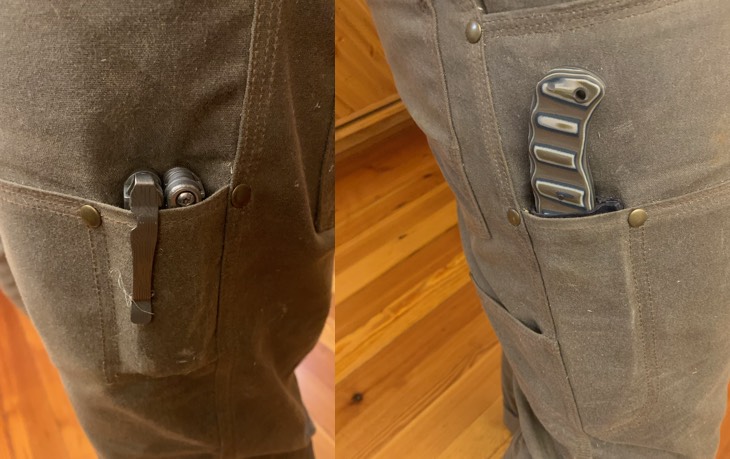
You are reporting the comment """ by on